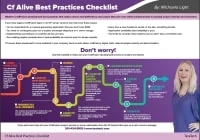ColdFusion server optimization is one of the most crucial parts of maintaining a healthy IT ecosystem. A CIO’s work involves managing two “machines” — the people behind the IT department and the silicon devices they use. The two collide at servers and applications, often reflecting the state of harmony (or chaos) within your organization.
When your ColdFusion server slows down, it’s rarely just a technical issue. Often, poor performance stems from overlooked maintenance or underperforming configurations. Let’s fix that.
Contents
- What Can Be Done to Optimize Your ColdFusion Server and Application?
- 1. Adopt a Preventative-Maintenance Attitude
- 2. Keep Your Java Virtual Machine (JVM) Snappy
- 3. Take Care of the Garbage Man
- 4. Level-Up Your ColdFusion Web Server Connector
- Maintaining Control of Your ColdFusion Environment
- FAQs About ColdFusion Server Optimization
What Can Be Done to Optimize Your ColdFusion Server and Application?
-
Adopt a Preventative-Maintenance Attitude
-
Keep Your JVM Snappy
-
Take Care of the Garbage Man
-
Level-Up Your Web Server Connector
1. Adopt a Preventative-Maintenance Attitude
Every major IT department mistake begins with neglect. A slow or unstable app might mean a developer skipped maintenance—or a server desperately needs tuning. The best ColdFusion server optimization strategy is to catch these problems before they catch you.
Plan Ahead
Schedule regular maintenance with your team. Keep those dates sacred. Prevent downtime through early intervention.
Preventative Maintenance
Like cars, servers need checkups even when nothing’s wrong. Regular inspections prevent silent degradation of performance.
Use Server Monitoring Tools
Manual diagnostics waste time. Instead, use APM tools like FusionReactor or ColdFusion Performance Monitoring Toolset to detect issues before users notice them.
Test Regularly
Modern testing tools can automate performance diagnostics. Read our guide on testing ColdFusion web applications for detailed steps.
Protect Your Property
Security is performance. Keep ColdFusion patched, and consider adding layers from third-party services like Foundeo. See how one company improved their ColdFusion security.
2. Keep Your Java Virtual Machine (JVM) Snappy
Your JVM is the heart of your ColdFusion server. Over time, it accumulates virtual residue—unused processes and memory leaks that slow everything down.
JVM Optimization Techniques
- Use cleanup tools like FusionReactor or Adobe’s Performance Monitoring Toolset.
- Inspect and optimize memory allocation manually to prevent leaks.
3. Take Care of the Garbage Man
Garbage collection keeps ColdFusion memory clean, but overactive GC cycles drain system performance.
Understand Garbage Collection
ColdFusion’s GC process removes unused objects but can consume too many resources if misconfigured.
Optimize GC Frequency
Experiment with ColdFusion’s four GC modes to balance cleanup efficiency with runtime performance.
4. Level-Up Your ColdFusion Web Server Connector
The web server connector determines how ColdFusion communicates with the web server. Tune it regularly using the ColdFusion 2018 Performance Monitoring Toolkit’s auto-tuner feature.
Maintaining Control of Your ColdFusion Environment
ColdFusion server optimization isn’t just about speed. It’s about ownership. Assess, test, and recalibrate configurations regularly to ensure peak performance and long-term stability.
FAQs About ColdFusion Server Optimization
What Are the Four Main Steps to Optimize a ColdFusion Server?
- Adopt a preventative maintenance attitude
- Keep your JVM optimized
- Manage garbage collection efficiently
- Optimize your web server connector
How Can I Improve My ColdFusion Server’s Performance Through Preventative Maintenance?
- Schedule regular system maintenance
- Use FusionReactor or APM tools
- Conduct automated tests
- Keep ColdFusion patches updated
- Document configuration changes
What Issues Can Affect JVM Performance in ColdFusion?
- Memory leaks
- Residual threads
- Inefficient code execution
- Poor GC configuration
How Does Garbage Collection Impact ColdFusion Performance?
- Excessive GC cycles consume CPU
- Misconfigured modes cause memory instability
- Balanced tuning improves uptime
What Security Measures Should I Implement for My ColdFusion Server?
- Install the latest patches
- Use Foundeo or similar security tools
- Enforce role-based access
- Perform regular audits
Need a deeper assessment? Contact our experts for a free ColdFusion optimization consultation.
When Should I Upgrade My ColdFusion Server?
- When load capacity hits consistent limits
- When response times lag
- When new application demands exceed hardware

Michaela Light is the host of the CF Alive Podcast and has interviewed more than 100 ColdFusion experts. In each interview, she asks "What Would It Take to make CF more alive this year?" The answers still inspire her to continue to write and interview new speakers.
Michaela has been programming in ColdFusion for more than 20 years. She founded TeraTech in 1989. The company specializes in ColdFusion application development, security and optimization. She has also founded the CFUnited Conference and runs the annual State of the CF Union Survey.
And to continue learning how to make your ColdFusion apps more modern and alive, I encourage you to download our free ColdFusion Alive Best Practices Checklist.
Because… perhaps you are responsible for a mission-critical or revenue-generating CF application that you don’t trust 100%, where implementing new features is a painful ad-hoc process with slow turnaround even for simple requests.
What if you have no contingency plan for a sudden developer departure or a server outage? Perhaps every time a new freelancer works on your site, something breaks. Or your application availability, security, and reliability are poor.
And if you are depending on ColdFusion for your job, then you can’t afford to let your CF development methods die on the vine.
You’re making a high-stakes bet that everything is going to be OK using the same old app creation ways in that one language — forever.
All it would take is for your fellow CF developer to quit or for your CIO to decide to leave the (falsely) perceived sinking ship of CFML and you could lose everything—your project, your hard-won CF skills, and possibly even your job.
Luckily, there are a number of simple, logical steps you can take now to protect yourself from these obvious risks.
No Brainer ColdFusion Best Practices to Ensure You Thrive No Matter What Happens Next
ColdFusion Alive Best Practices Checklist
Modern ColdFusion development best practices that reduce stress, inefficiency, project lifecycle costs while simultaneously increasing project velocity and innovation.
√ Easily create a consistent server architecture across development, testing, and production
√ A modern test environment to prevent bugs from spreading
√ Automated continuous integration tools that work well with CF
√ A portable development environment baked into your codebase… for free!
Learn about these and many more strategies in our free ColdFusion Alive Best Practices Checklist.
